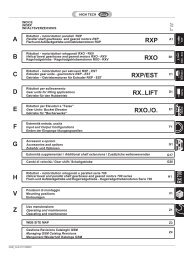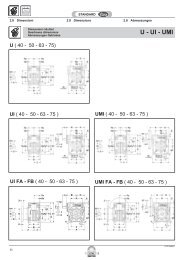AR/2-3 - STM POLSKA
AR/2-3 - STM POLSKA
AR/2-3 - STM POLSKA
Create successful ePaper yourself
Turn your PDF publications into a flip-book with our unique Google optimized e-Paper software.
1.9 Installazione<br />
Montare il riduttore in modo tale da eliminare<br />
qualsiasi vibrazione.<br />
Curare particolarmente l’allineamento del<br />
riduttore con il motore e con la macchina<br />
da comandare interponendo dove è possibile<br />
giunti elastici od autoallineanti.<br />
Quando il riduttore è sottoposto a sovraccarichi<br />
prolungati, urti o pericoli di<br />
bloccaggio, installare salvamotori, limitatori<br />
di coppia, giunti idraulici od altri dispositivi<br />
similari.<br />
Fare attenzione a non superare i valori<br />
consentiti di carico radiale ed assiale che<br />
agiscono sugli alberi veloce e lento.<br />
Assicurarsi che gli organi da montare sui<br />
riduttori siano lavorati con tolleranza<br />
ALBERO ISO h6 FORO ISO H7.<br />
Prima di effettuare il montaggio pulire e lubrificare<br />
le superfici al fine di evitare il pericolo<br />
di grippaggio e l’ossidazione da<br />
contatto.<br />
Il montaggio e lo smontaggio vanno effettuati<br />
con l’ausilio di tiranti ed estrattori utilizzando<br />
il foro filettato posto in testa alle<br />
estremità degli alberi.<br />
Durante la verniciatura si consiglia di proteggere<br />
gli anelli di tenuta per evitare che<br />
la vernice ne essichi la gomma pregiudicando<br />
la tenuta del paraolio stesso.<br />
Nel caso di montaggio dell'albero lento su<br />
calettatore:<br />
Pulire accuratamente le superfici di contatto<br />
dell'albero e del mozzo.<br />
Applicare sulle stesse una leggera pellicola<br />
d'olio.<br />
Inserire l'unità di bloccaggio all'esterno<br />
dell'albero cavo.<br />
Serrare le viti in modo graduale ed uniforme<br />
con sequenza continua sino a raggiungere<br />
la coppia di serraggio Ms<br />
indicata in tabella 1.7.<br />
Per raggiungere la coppia di serraggio Ms<br />
richiesta sono necessari più serraggi delle<br />
viti.<br />
I valori di T indicati in tabella sono calcolati<br />
per un montaggio ad olio.<br />
Attenzione: non usare bisolfuro di molibdeno<br />
o altri grassi, causa di notevoli riduzioni<br />
del coefficiente d'attrito.<br />
10<br />
1.9 Installation<br />
HIGH TECH line<br />
Install the gearbox to eliminate all vibrations.<br />
Take special care over alignment between<br />
the gear unit, the motor and the driven<br />
machine, fitting flexible or self-adjusting<br />
couplings wherever possible.<br />
When the gearbox is subject to prolonged<br />
overloads, shocks or possible jammings,<br />
fit thermostatic cut-outs, torque limiters,<br />
hydraulic couplings or other similar devices.<br />
Take care not to exceed the permitted radial<br />
and axial loads on the input and<br />
output shafts.<br />
Ensure that the components to assembly<br />
on the gearboxes are machined with tolerance<br />
SHAFT ISO h6 HOLE ISO H7.<br />
Before assembling clean and lubricate the<br />
surface to prevent jammings and contact<br />
oxidation.<br />
Assembly and disassembly should be<br />
made with care and possibly using the<br />
tapped hole in the end of the shaft which<br />
is provided for this purpose.<br />
When painting, protect the oilseals to prevent<br />
the paint from drying the rubber and<br />
impairing sealing properties.<br />
When assembling the output shaft on the<br />
shrink disk, please use the following instruction:<br />
Carefully clean the contact surfaces of the<br />
shaft and the hub.<br />
Pour on the same a light oil pellicle.<br />
Place the block unit outside the hollow<br />
shaft.<br />
Clamp the screws in a gradual and uniform<br />
way with a continuous sequence up<br />
to reach the tightening torque Ms indicated<br />
in table 1.7.<br />
Many screw clampings are requested to<br />
reach the tightening torque Ms.<br />
T values indicated in the table are calculated<br />
for an oil assembly.<br />
Attention: do not use molybdenim bisulphate<br />
or other greases; it would cause big<br />
reductions of friction coefficient.<br />
1.9 Montage<br />
Das Getriebe ist so zu montieren, daß<br />
Schwingungen ausgeschlossen werden.<br />
Insbesondere ist darauf zu achten, dass<br />
das Getriebe sowohl mit dem Motor als<br />
auch mit der anzutreibenden Maschine<br />
fluchtet, was durch die Verwendung elastischer<br />
oder selbstfluchtender Kupplungen<br />
erreicht werden kann.<br />
Wenn das Getriebe längeren Überlasten,<br />
Schlägen oder Sperrzeiten ausgesetzt ist,<br />
sind Motorschalter, Rutschkupplungen,<br />
hydraulische Kupplungen oder ähnliche<br />
Vorrichtungen anzubringen.<br />
Achten Sie darauf, daß die zulässigen Querund<br />
Axialbelastungen an Antriebs- und<br />
Abtriebswelle nicht überschritten werden.<br />
Achten Sie auch darauf, daß die an den<br />
Getriebe montierten Elemente mit folgenden<br />
Toleranzen bearbeitet sind: WELLE<br />
ISO h6, BOHRUNG ISO H7.<br />
Vor der Montage sind die Flächen zu reinigen<br />
und zu schmieren, um ein Festfressen<br />
bzw. Kontaktoxidation zu vermeiden.<br />
Montage und Demontage sollten mit Hilfe<br />
von Zugstangen und Ausziehvorrichtungen<br />
unter Verwendung der Gewindebohrungen<br />
an den Wellenenden erfolgen.<br />
Während des Lackierens sollten die Dichtungsringe<br />
geschützt werden, um zu vermeiden,<br />
daß der Lack den Gummi ausstrocknet,<br />
was die Funktion der Öldichtung<br />
beeinträchtigen könnte.<br />
Bei der Montage der Abtriebswelle mit Hilfe<br />
einer Schrumpscheibe ist folgendes zu<br />
beachten:<br />
Die 4 Kontaktoberflächen der Welle und der<br />
Nabe sollten sorgfältig gereinigt werden.<br />
Einen leichten Ölfilm auf diesen Flächen<br />
auftragen.<br />
Die Sperreinheit auf der Außenseite der<br />
Hohlwelle anbringen.<br />
Die Schrauben stufenweise und gleichmäßig<br />
nacheinander anziehen, bis das Anzugsmoment<br />
Ms, das in der Tabelle 1.7<br />
angegeben wird, erreicht ist.<br />
Für das Erreichen des erforderlichen Anzugsmoments<br />
Ms müssen die Schrauben<br />
mehrfach angezogen werden.<br />
Die in der Tabelle angegebenen Werte Mt<br />
und Fass wurden für eine ölgschmierte<br />
Montage berechnet.<br />
Achtung: es sollten aufgrund der signifikanten<br />
Reduzierung des Reibungsbeiwertes<br />
kein Molybdändisulfid oder andere<br />
Fette verwendet werden.<br />
CT17IGBD0





